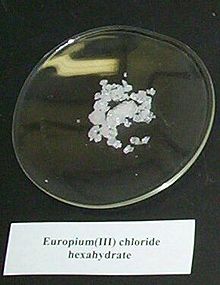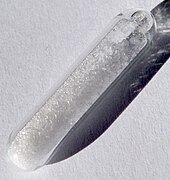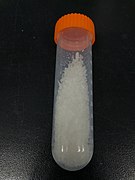Europium compounds
Europium compounds are compounds formed by the
Properties of europium compounds
| Formula | Color | Crystal structure | Space group | No |
|---|---|---|---|---|
| EuBr2 | white | SrBr2 | P4/n | 85 |
| EuBr3 | grey[3] | PuBr3 | Cmcm | 63 |
| EuCl2 | white | PbCl2 | Pnma | 62 |
| EuCl3 | yellow | UCl3 | P63/m | 176 |
| EuF2 | dark yellowish[4] | fluorite[5] | Fm3m | 225 |
| EuF3 | white | LaF3[6]
|
Pnma | 62 |
| EuI2 | yellow | monoclinic
|
P21/c | 14 |
| EuI3 | colorless[7] | BiI3 | R3 | 148 |
EuH2
|
dark red[8] | PbCl2 | Pnma | 62 |
| Eu(OH)2 | pale yellow[9] | orthorhombic
|
P21am[9] | 26 |
| Eu(OH)3 | pale pink[10] | hexagonal
|
P63/m[11] | 176 |
| EuO | violet[12] | fluorite | Fm3m | 225 |
| Eu2O3 | white | monoclinic
|
C2/m | 12 |
| EuS | black | fluorite | Fm3m | 225 |
EuSe
|
black | fluorite | Fm3m | 225 |
| EuTe | black | fluorite | Fm3m | 225 |
| EuSO4 | white | orthorhombic
|
Pnma | 62 |
Chalcogenides
Oxides
- 2 Eu2O3 + 2 EuOCl + 2 LiH → 2 Eu3O4 + 2 LiCl + H2↑
Europium(III) oxide is the most stable
Eu(H2O) and Eu(H2O)2 complexes can be obtained by the reaction of metallic europium in solid argon with water. Eu(H2O) is rearranged to obtain HEuOH, which is further decomposed into EuO and H2; Eu(H2O)2 is decomposed into Eu(OH)2 and H2.[16]
Other chalcogenides
Europium(III) sulfide can be obtained by the decomposition of Eu(Et2NCS2)3 then at 500~600 °C.
- Eu2O3 + 3 H2S → 2 EuS + 3 H2O + S
The selenides,
Europium oxysulfide is obtained by reacting europium(III) oxide in a carbon disulfide/argon/low-pressure oxygen stream. It is a solid of the triclinic crystal system, with the space group P3m1, and its optical band gap is 4.4 eV.[23] Europium oxyselenide and europium oxytelluride can be prepared by reacting europium(III) oxide with selenium or tellurium at 600 °C.[24] The oxyselenide is heated in air and oxidized to oxyselenite.[25] A similar reaction occurs with oxytelluride to give Eu2TeO6.[26]
Halides

Europium metal reacts with all the halogens:
- 2 Eu + 3 X2 → 2 EuX3 (X = F, Cl, Br, I)
This route gives white europium(III) fluoride (EuF3), yellow europium(III) chloride (EuCl3), gray[3] europium(III) bromide (EuBr3), and colorless europium(III) iodide (EuI3). Europium also forms the corresponding dihalides: yellow-green europium(II) fluoride (EuF2), colorless europium(II) chloride (EuCl2) (although it has a bright blue fluorescence under UV light),[27] colorless europium(II) bromide (EuBr2), and green europium(II) iodide (EuI2).[28]
Europium can form all four trihalides. They are strong
- Eu2O3 + 6 NH4Cl → 2 EuCl3 + 3 H2O + 6 NH3↑
- EuCl3·6H2O + 6 SOCl2 → EuCl3 + 6 SO2↑ + 12 HCl↑
Among them, europium(III) iodide can only be obtained by reacting europium(III) oxide and hydroiodic acid.[30]
In addition, europium can also form all four dihalides. They can generally be prepared by reducing the corresponding europium trihalide with
- 2 EuX3 + H2 → 2 EuX2 + 2 HX
Europium(II) iodide can also be obtained by direct treating the reagent with ammonium iodide.[31] Of the dihalides, EuF2 and EuI2 are yellow, and EuCl2 and EuBr2 are white, although when irradiated by ultraviolet lite, EuCl2 has a bright blue fluorescence.[27]
Pnictides
Europium(III) nitride is a black solid that can be prepared by the reaction of metallic europium in a stream of ammonia in corundum boats in fused quartz tubes at 700 °C:[32]
- 2 Eu +2 NH3 → 2 EuN + 3 H2
In this reaction, the europium is oxidized and the
Organoeuropium compounds
Organoeuropium compounds are a class of
- EuCl3 + 3 C5H5Na → (C5H5)3Eu + 3 NaCl
- EuI2 + 2 (C5HiPr4)Na → (C5HiPr4)2Eu + 2 NaI
Europium bis(tetraisopropylocene) is an orange-red solid that can be melted at 165 °C.[47] The complex of cyclononatetraene and europium(II) can be prepared by a similar method, and its toluene solution emits blue-green fluorescence at 516 nm, compared with other organic europium(II) sandwich complexes (about 630 nm) with a clear blue shift.[48]
In addition to the preparation of organo-europium compounds by metathesis reaction, metal europium can also be directly involved in the reaction, such as the reaction of europium and pentamethylcyclopentadiene to generate light orange bis(pentamethylcyclopentadiene) europium;[47] and the reaction between cyclooctatetraene and europium gives the pale green cyclooctatetraene europium.[49]
Other compounds
- EuSO4 + Na2CO3 + xH2O → EuCO3·xH2O + Na2SO4
- EuSO4 + (NH4)2C2O4(saturated) + H2O → EuC2O4·H2O + (NH4)2SO4
Europium(III) sulfate can be directly obtained by reacting europium(III) oxide and dilute sulfuric acid, and crystallized, and dehydration of hydrate can obtain the anhydrous form. Europium(III) sulfate is soluble in water, and its octahydrate has a solubility of 2.56 g at 20 °C.[51] Europium(III) sulfite (Eu2(SO3)3·nH2O,n=0, 3, 6[52]) and its basic salt (EuOHSO3·4H2O[53]) are known, and heating the sulfite in a carbon monoxide atmosphere will dehydrate to obtain the anhydrous form, and after Eu2O2SO4, finally obtain the oxysulfide Eu2O2S.[54]
Europium(III) nitrate can be obtained by reacting europium(III) oxide and

Europium(III) carbonate is one of the carbonates of europium, which can be obtained by reacting a dilute solution of
- Eu2(C2O4)3 → 2 EuC2O4 + 2 CO2↑
Applications
Compounds of Eu3+ can emit red light under excitation. For example, europium(III) oxide can be used in picture tube televisions[67] and europium-doped yttrium oxysulfide (Y2O2S:Eu3+) can be used as phosphors.[68] In addition, europium compounds can also be used in the manufacture of anti-counterfeiting materials.[69]
Based on the properties of
Eu(OCC(CH3)3CHCOC3F7)3 (abbreviated Eu(fod)3, where the fod ligand is the anion of the commercially available 6,6,7,7,8,8,8-heptafluoro-2,2-dimethyl-3,5-octanedione) serves as a Lewis acid
Gallery
See also
References
- ^ S2CID 54527606.
- ^ 无机化学丛书. pp 187-188. 1.2.3 氧化态及电极电势.
- ^ ISBN 9780849386718.
- ^ Zhao, Yongzhi; Ma, Ying; Hou, Shaochun; Zhang, Wenjuan; Wang, Jingjing; Ding, Yanrong; Hao, Yifan (2017). "Europium(II) fluoride structure research". Chinese Rare Earths (in Chinese). Archived from the original on 2022-01-14.
- ^ ISBN 978-3-432-02328-1.
- .
- ISBN 978-1482208689.
- PMID 23581546.
- ^ a b c H. Baernighausen. Lattice constants and space group of the isotypic compounds Eu(OH)2·H2O, Sr(OH)2·H2O, and Ba(OH)2·H2O. Zeitschrift fuer Anorganische und Allgemeine Chemie, 1966. 342 (5-6): 233-239. ISSN: 0044-2313.
- ^ 《无机化学丛书》. 第七卷 钪 稀土元素. 易宪武 等主编. 科学出版社. P168~171. (2)氢氧化物
- .
- ISBN 3527306730
- ^ a b c d 无机化学丛书. pp 200-203. 2. 氧族化合物; pp 215. 3. 氧化物及氢氧化物.
- ISSN 0021-8979.
- ISSN 0044-457X.
- from the original on 2020-08-01. Retrieved 2019-10-26.
- ISSN 0161-6374.
- ISSN 0044-457X.
- ISSN 0959-9428.
- ISBN 978-0-470-13241-8.
- ISBN 978-1-4832-6013-6.
- ISSN 0863-1786. Retrieved 3 April 2023.
- ISSN 0025-5408.
- ISSN 0002-337X.
- ISSN 0303-4100.
- ISSN 0020-1669.
- ^ .
- ISBN 0-12-352651-5.
- ^ 无机化学丛书. pp 210-215. 2. 卤素化合物
- ^ Emel'yanov, V. I.; Kuznetsova, L. I.; Abramova, L. V.; Ezhov, A. I. Systems Eu2O3-HI-H2O and EuI3-HI-H2O at 25°C. Zhurnal Neorganicheskoi Khimii, 1997. 42(8): 1394-1396.
- ISSN 1002-0721.
- ISSN 0044-2313.
- .
- .
- S2CID 98808817.
- ISSN 0921-4526.
- ISSN 0009-241X.
- ISSN 0020-1650.
- ^ Giacomo Bruzzone, Assunta Ferro Ruggiero, Giorgio L. Olcese (1964), Sul comportamento di ittrio, europio e itterbio nei composti MX con i metalloidi del V e VI gruppo., vol. 36, Atti della Accademia Nazionale dei Lincei, Classe di Scienze Fisiche, Matematiche e Naturali, Rendiconti, pp. 66–69
{{citation}}: CS1 maint: multiple names: authors list (link) - ^ K. E. Mironov, G. P. Brygalina, V. N. Ikorskii (1974), Magnetism of europium phosphides, vol. 1, Proc. Rare Earth Res. Conf., 11th, pp. 105–114
{{citation}}: CS1 maint: multiple names: authors list (link) - .
- ISBN 9780444852168. Retrieved 26 June 2023.
- .
- ISSN 0021-8898.
- ISSN 0021-8898.
- ^ 无机化学丛书. pp 338. 2.3.7 稀土元素有机化合物.
- ^ ISSN 0044-2313.
- PMID 28524187.
- ISSN 1932-7447.
- ^ a b 无机化学丛书. pp 203. 3. Ln2+的水溶液体系.
- ^ 无机化合物合成手册. pp 258-259. 819 硫酸盐.
- ISSN 0303-4100.
- ISSN 0002-7863.
- ISSN 0040-6031.
- ISBN 978-1-4831-5777-1.
- ISBN 978-0-444-53591-7.
- ISBN 978-1-4398-7989-4.
- ^ 高胜利, 刘翊纶, 杨祖培. 稀土硝酸盐的制法、性质及结构 Archived 2019-07-08 at the Wayback Machine. 稀土, 1990 (4): 23-28.
- ^ 无机化合物合成手册. pp 260-261. 820 硝酸盐.
- ISSN 0167-577X.
- ISSN 1528-7483.
- S2CID 95164970.
- ^ 无机化合物合成手册. pp 261-263. 822 碳酸盐.
- ^ ISSN 0037-8968.
- ^ Hadi, Abdul Nada; Li, Wei; Feng, Guo-Qiang; Lu, Pei-Xiang. Synthesis, structure, photoluminescence and thermal expansion of a rare earth formate oxalate framework Archived 2019-07-08 at the Wayback Machine. Chinese Journal of Structural Chemistry, 2018. 37 (2): 262-269. DOI: 10.14102/j.cnki.0254-5861.2011-1683.
- ISSN 0022-1902.
- ISBN 978-84-89784-33-8. Archivedfrom the original on 2020-03-13. Retrieved 2019-07-06.
- ^ 无机化学丛书. pp 263. 1. 稀土发光材料.
- ^ 魏俊青, 孙诚, 黄利强. 稀土铕配合物在荧光防伪油墨中的应用 Archived 2019-07-08 at the Wayback Machine. 天津科技大学学报, 2012(4):36-39.
- S2CID 22764388.
- ISSN 0025-5408.
- PMID 17193029.
- PMID 32253317.
External reading
- Yi Xianwu, Huang Chunhui, Wang Wei, Liu Yujiu, Wu Jinguang. Inorganic Chemistry Series Vol.7 Scandium and Rare Earth Elements. Beijing: Science Press, 1992. ISBN 9787030305749.
- The Handbook of Synthesis of Inorganic Compounds Vol.2. Beijing: Chemical Industry Press, 1986. CSBN 15063·3726 (Synthesis of Inorganic Compounds II. Tokyo: Maruzen Co., Ltd., 1977) Edited by the Chemical Society of Japan. Translated by An Jiaju and Chen Zhichuan.







